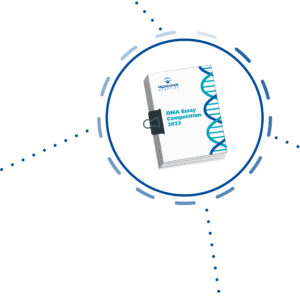Tay-Sachs disease (also called Tay-Sachs syndrome) belongs to a group of diseases called the sphingolipidoses, a subgroup of lysosomal storage diseases. Decreased activity of isozyme A of β-N-acetylhexosaminidase (HEX A) leads to impaired degradation of ganglioside GM2 in lysosomes. This is caused by pathogenic variants in the HEXA gene. The enzyme defect leads to a progressive accumulation of GM2 in the neurons of the central nervous system, resulting in their demise and demyelination. Three forms of progression are distinguished:
The classic course is characterized by progressive weakness, loss of motor skills from three to six months of age, decreased visual attention, increased startle response, and a cherry-red spot on the macula as a sign of macular cell death. This is followed by a developmental plateau and loss of learned skills at eight to ten months with progressive macrocephaly and proportional ventricular enlargement at about 18 months of age. Seizures occur regularly at 12 months of age with further deterioration in the second year of life. Death usually occurs between two and three years of age; rarely, survival to seven years of age has been observed.
The sub-acute juvenile form of the disease is associated with normal developmental milestones until the age of two. From the age of 3 to 11 years, the first motor impairments such as coordination difficulties or an abnormal gait as well as dysarthria become apparent. This is followed by other symptoms of the classic course, such as the cherry-red spot on the macula, a developmental plateau, and loss of learned skills due to global brain atrophy. Progressive spasticity, dysphagia, and seizures occur by the end of the first decade of life. Death, usually by aspiration, typically occurs within the second decade of life.
The late-onset form occurs in older teens or young adults with a slowly progressive spectrum of neurological symptoms. These include lower extremity weakness with muscle atrophy, dysarthria, coordination difficulties, tremor, mild spasticity and/or dystonia, and psychiatric manifestations including acute psychosis. CNS imaging shows isolated cerebellar atrophy.
There is clinical variability, even among affected members of the same family, in both the subacute juvenile and late-onset forms.
Molecular genetic testing of the HEXA gene should be preceded by enzyme activity determination of β-N-acetylhexosaminidase. Characteristically, isozyme A activity is absent or largely absent with normal or increased isozyme B activity.
All forms of Tay-Sachs disease are inherited in an autosomal recessive manner, i.e., both alleles must be affected for the enzyme deficiency to manifest clinically. It is a rare disease with a worldwide incidence of about 1:250,000 - 360,000. In Ashkenazi Jews, the incidence is about 100 times higher. Therapy is primarily symptomatic and consists of adequate nutrition and hydration, treatment of infectious diseases, respiratory protection, and control of seizures. A number of drug therapies are currently being tested.
References
Toro et al. 2020, GeneReviews®, HEXA Disorders, GeneReviews® [Internet] / Solovyeva et al. 2018, Front Physiol 9:1663





















